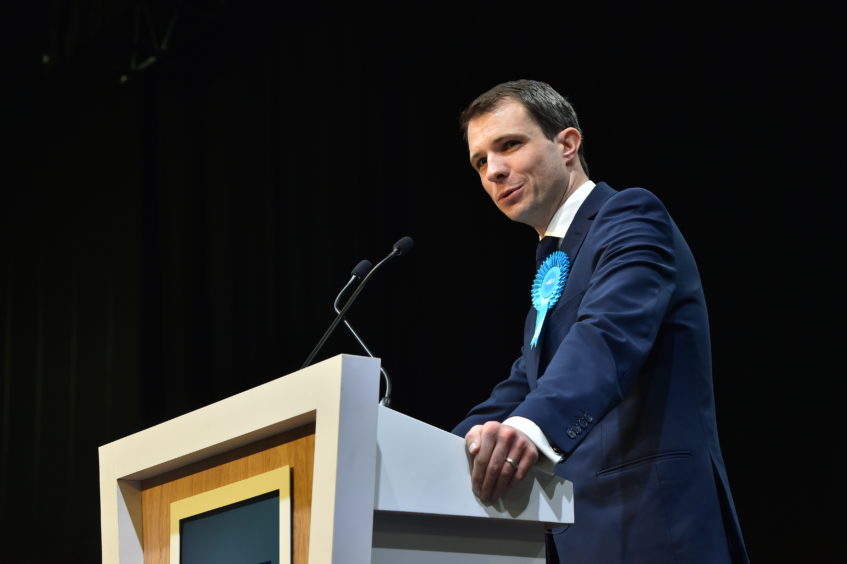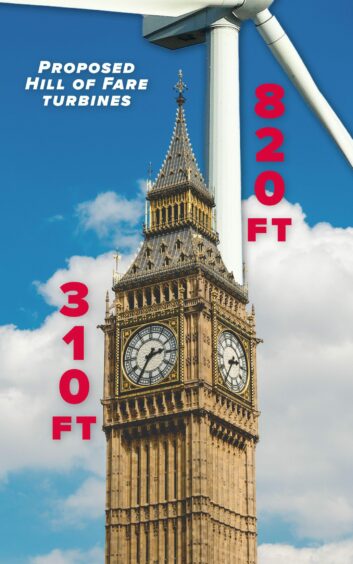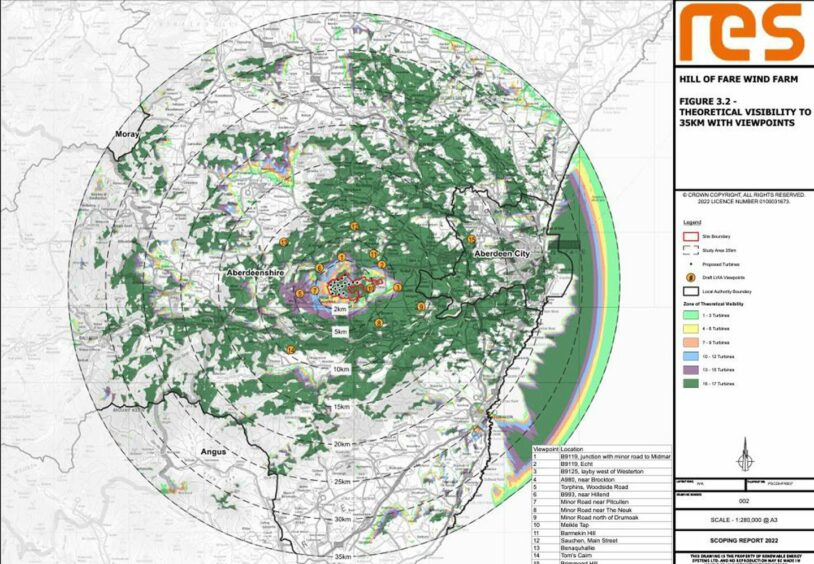
The MP for West Aberdeenshire and Kincardine, Andrew Bowie, has struck out at the proposed 820ft turbines set for Aberdeenshire, saying “they’re simply too big.”
Developer RES plans to build 17 giant turbines on the hill of fare, less than four miles from the town of Banchory, in what would be one of the tallest developments in Scotland.
Bowie has criticised the proposed wind farm as it would stand less than six-and-a-half miles from heritage and cultural sites, including the Kincardine O’Neil Conservation Area, also citing that due to the placement and height of the turbines, they will be visible from as far away as Aberdeen City, Moray, and Angus.
He said: “These turbines will be of a scale not seen on the Scottish landscape ever
before, they constitute a substantial deviation from Aberdeenshire Council’s
recommended tip height of 250ft and will tower above natural landmarks for
miles in all directions”
At their proposed height, each turbine will stand at twice the height of London’s Big Ben.
However, RES has defended the height of its turbines, saying: “Turbine technology has advanced considerably in recent years, meaning that turbines are now taller and more efficient which enables them to generate a significantly greater amount of renewable electricity per turbine.
“Modern taller turbines provide more electricity, which helps address the climate emergency, cost of living crisis, and security of energy supply.”
Mr Bowie has also expressed concerns over the impact the turbines may have on local wildlife, saying: “We must continue to move towards Net Zero, but we cannot do so at the expense of our natural environment. Birds and animals will be negatively
impacted, especially with the size and number of turbines.”
The farm’s developer is confident that its project will have no negative impact on local wildlife with a spokesperson saying: “RES takes the environmental protection and surrounding area’s ecology seriously when determining whether a site is suitable for developing wind projects.
“Investigating how bird species use the area is an important factor in the design of the site. Already, we have commissioned over 100 hours of baseline ornithological survey work during breeding and non-breeding seasons to build our understanding of the species on site.
“We have also conducted a range of non-avian studies. Assessment work will continue over the coming months as the design develops and infrastructure siting is refined.
“As part of the Environmental Impact Assessment (EIA) process, appropriate mitigation will be proposed and clearly set out in the planning application. This will include a draft Habitat Management Plan which will propose methods for mitigation or enhancement for biodiversity.”
Public consultations
Public consultations have been held to gauge public opinion on the development, taking place in the village of Crathes to the east of Banchory on Tuesday 11th October.
The consultations also include an open online form for those not in attendance at the in-person meetings.
However, this has not set Mr Bowie’s mind at ease.
In a letter to the SNP/Green Scottish Government, the MP wrote: “When it comes to proposals of this nature the Scottish Government have a track record of seeking consultation from the local authority, and then ignoring it or overruling it if they don’t like the answer.”
Project Manager at RES, Paula Batchelor, said, following day one of the consultations: “We are delighted with the turn-out and level of engagement at our first two exhibition events in Crathes and Echt for our Hill of Wind Farm proposal.
“Around 160 people attended the exhibitions, and more than 60 comments were handed in on the day.
“It’s great to get this level of engagement so early on in the project as feedback at this stage can help to influence and shape the design.
“We would like to thank everyone who took the time to come along to the events and engage with us.”
Overall the Hill of Fare wind farm developers, RES, are confident of the benefits its 17 giant turbines could bring to the area.
A RES spokesperson said: “The turbines proposed at Hill of Fare would allow for far greater benefits in terms of renewable electricity generation per turbine than smaller turbines would, and in turn reduces the total number of turbines required in a layout to generate the same amount of electricity.
“Wind energy is a free and inexhaustible resource which has an important role to play as part of a balanced energy mix.
“It increases energy security by reducing our reliance on imports and is not subject to sudden price fluctuations or the uncertainty of global markets.
“At our public exhibitions, we have provided a range of information, including visualisations to help give an impression of what the proposed wind farm may look like from viewpoints in the local area, and the opportunity for the wider community to discuss the proposal with members of our project team.”
Recommended for you


 © Supplied by Andrew Bowie
© Supplied by Andrew Bowie © Supplied by RES
© Supplied by RES